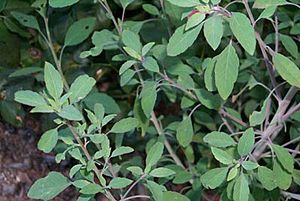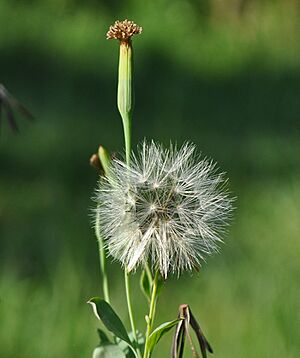Porophyllum ruderale facts for kids
Quick facts for kids Porophyllum ruderale |
|
|---|---|
 |
|
| Scientific classification | |
| Genus: |
Porophyllum
|
| Species: |
ruderale
|
Porophyllum ruderale is a plant that grows every year. Its leaves are often used to add flavor to food, much like an herb. People describe its taste as a mix between arugula, cilantro, and rue. This plant is very popular in Mexico and South America, where it's a common ingredient in salsas. When it's fully grown, the plant can reach about 1.5 meters (5 feet) tall and 0.9 meters (3 feet) wide.
It's quite easy to grow this plant from seeds. It likes soil that drains water well, and you should let the soil dry out a bit before watering it again.
Contents
Many Names for This Plant
Because many different cultures have used Porophyllum ruderale, it has many names! Some common names include Bolivian coriander, quillquiña (or quirquiña), yerba porosa, killi, pápalo, tepegua, rupay wachi, mampuritu, pápaloquelite, and summer cilantro.
Even though it's called "Bolivian coriander" or "summer cilantro," this plant is not actually related to the regular cilantro plant.
Pápalo in Mexico
In Mexico, the names pápaloquelite and pápalo are often used. This herb is a popular addition to tacos. Not everyone likes its strong taste, but many people find that it makes tacos, Mexican salsas, and soups taste even better.
How it's Used in Bolivia
In Bolivia, this plant is a key ingredient in a sauce called llajwa. It's usually mixed with tomatoes and a type of chili pepper called locotos.
Pápalo in Puebla Cuisine
In the region of Puebla in Mexico, pápalo is used as a special topping for traditional cemita sandwiches. These are a regional type of Mexican torta (sandwich).
People in the ancient Azteca era also used pápalo. They used it as food, but not as medicine.
Health Benefits of Pápalo
Some studies suggest that pápalo might have good health benefits. It may help lower cholesterol and blood pressure. It could also help with digestion, making it easier for your body to break down food.
Pápalo is also used in traditional medicine to help with swelling from injuries. People have also consumed it to help with high blood pressure, liver problems, and stomach issues.
See also
 In Spanish: Cilandro boliviano para niños
In Spanish: Cilandro boliviano para niños


